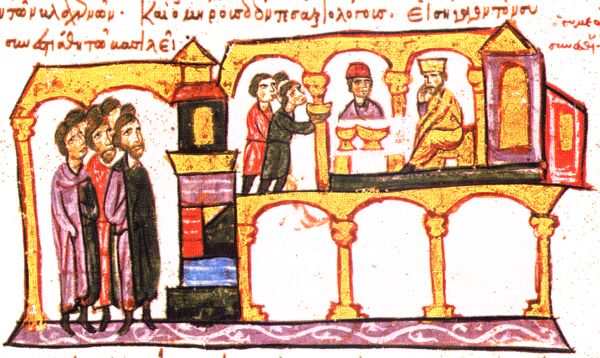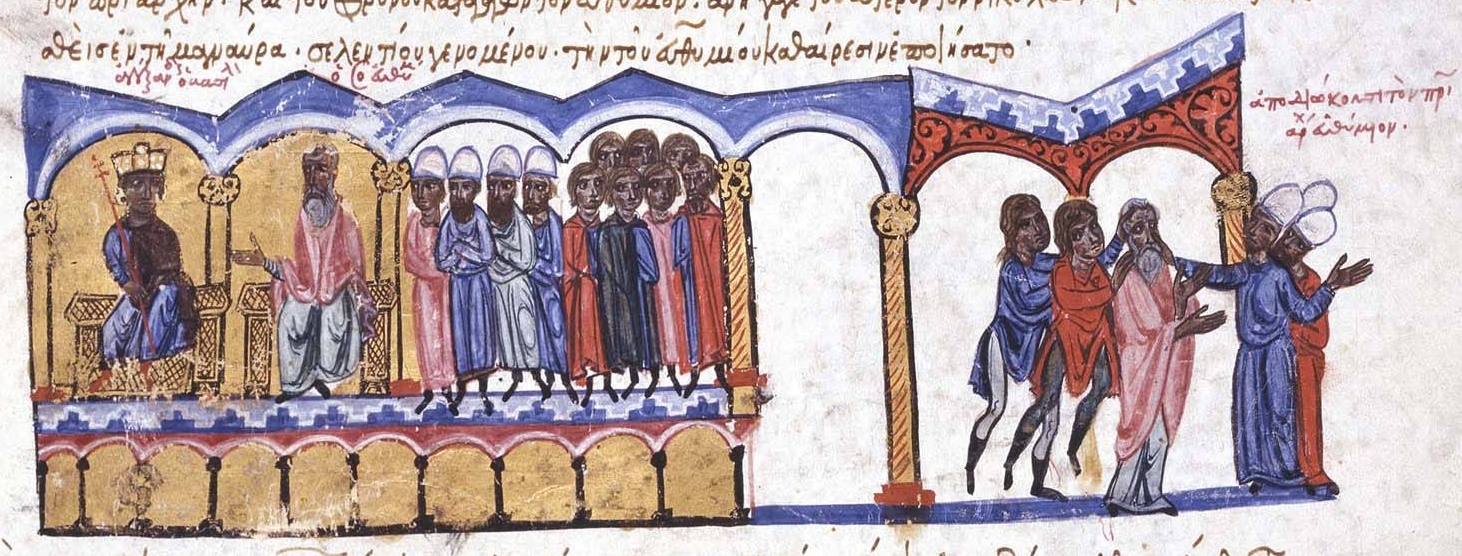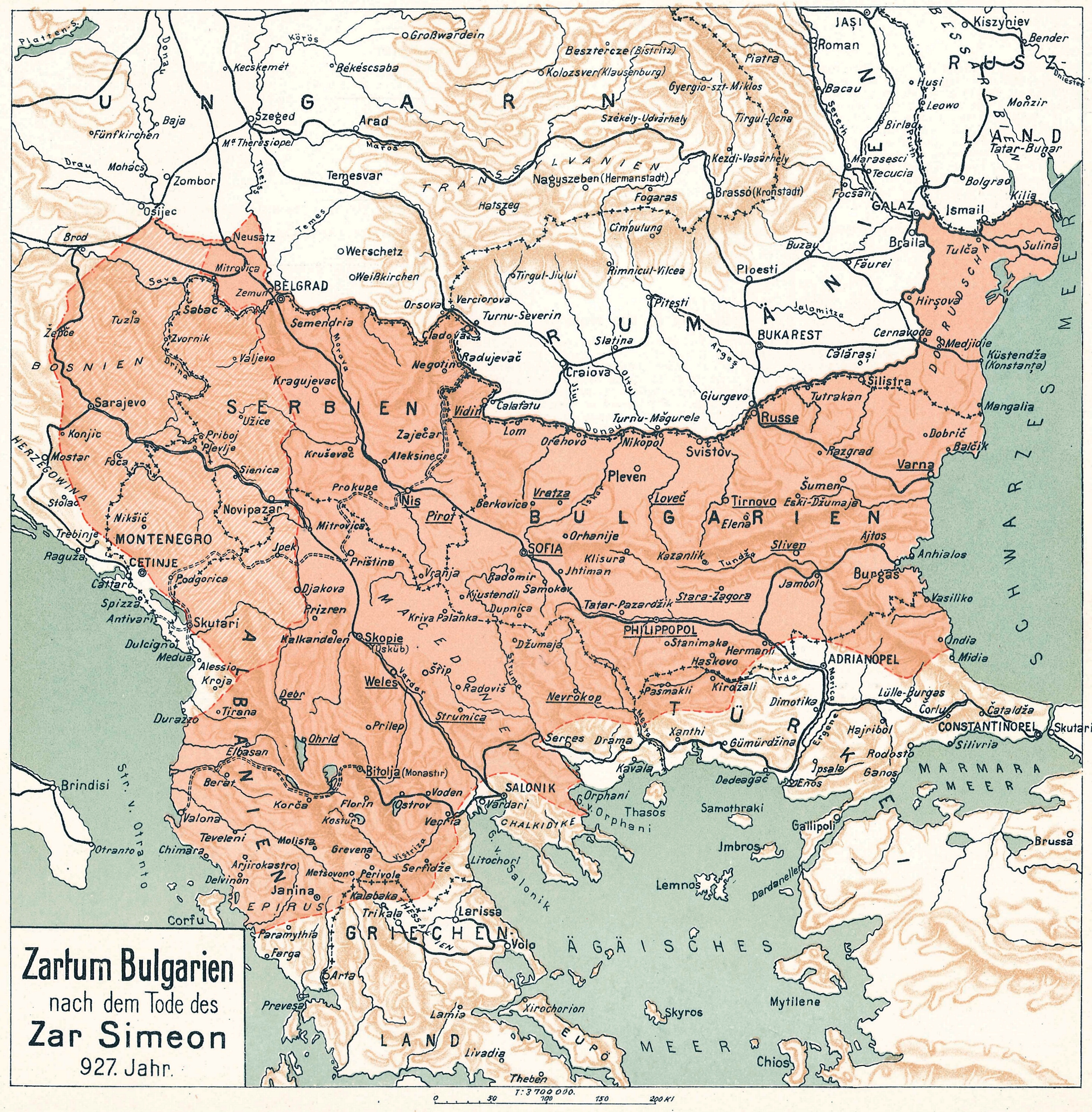|
Archont Petar
Petar Gojniković or Peter of Serbia ( sr-cyr, Петар Гојниковић, gr, Πέτρος; ca. 870 – 917) was Prince of the Serbs from 892 to 917. He ruled and expanded the First Serbian Principality and won several wars against other family members that sought the crown. He was the first Serbian monarch with a Christian (non-Slavic) name. Petar was the son of Gojnik, the youngest son of Vlastimir (r. 831–851) of the first Serbian dynasty (ruling since the early 7th century). Early life Petar was born between 870 and 874, as the son of the Prince Gojnik, the youngest son of dynastic founding father Vlastimir. His Byzantine Christian name, in relation to the previous generation of pagan names, shows the spread of Christianization among the Serbs.''The entry of the Slavs into Christendom''p. 209/ref> At the time of his birth, Serbia was ruled as an oligarchy consisting of the three brothers Mutimir, Gojnik and Strojimir, although Mutimir, the oldest, had ... [...More Info...] [...Related Items...] OR: [Wikipedia] [Google] [Baidu] |
List Of Serbian Monarchs
This is an archontological list of Serbian monarchs, containing monarchs of the medieval principalities, to heads of state of modern Serbia. The Serbian monarchy dates back to the Early Middle Ages. The Serbian royal titles used include Knyaz (Prince), Grand Župan (Grand Prince), King, Tsar (Emperor) and Despot. Early medieval Serbian states (7th century–1166) Vlastimirović dynasty (7th century–960) The Vlastimirović dynasty was the first royal dynasty of the Serb people. Byzantine emperor Constantine VII ''Porphyrogenitus'' (r. 913–959) mentions that the Serbian throne is inherited by ''the son'', i.e. the first-born, though in his enumeration of Serbian monarchs, on one occasion there was a triumvirate. ,, The Serbs established several polities by the 10th century: ''Serbia'' or ''Zagorje'' (''hinterlands'') which consisted of ''Serbia'' (known as "Rascia" in historiography of the High Middle Ages), and Bosnia; and ''Pomorje'' (''maritime'') which consist ... [...More Info...] [...Related Items...] OR: [Wikipedia] [Google] [Baidu] |
Bran Mutimirović
Bran Mutimirović ( la, Branus) was a Serbian prince, son of Serbian ruler Mutimir. He and Stefan escorted Khan Boris I of Bulgaria to the Rascian-Bulgar border after the Serbs successfully fought off the Khan's army in an attempted revenge to the defeat of Presian years earlier by their grandfather Vlastimir. Bran and Stefan were given presents for the escort, and in turn gifted 2 slaves, 2 falcons, 2 dogs, and 80 furs as a symbol of friendship, the Bulgars were pleased with the tribute. After the death of his father Mutimir, his elder brother Pribislav took the Serbian crown, but was deposed after a year by their cousin Petar Gojniković and fled with Bran and Stefan to Croatia. Three years after the accession of Petar, Bran rebelled against him but was captured and blinded. He was married and had a son, Pavle Branović.''The Late Medieval Balkans: A Critical Survey from the Late Twelfth Century to the Ottoman Conquest''. John Van Antwerp Fine John V. A. Fine Jr. (born 19 ... [...More Info...] [...Related Items...] OR: [Wikipedia] [Google] [Baidu] |
Constantinople
la, Constantinopolis ota, قسطنطينيه , alternate_name = Byzantion (earlier Greek name), Nova Roma ("New Rome"), Miklagard/Miklagarth (Old Norse), Tsargrad ( Slavic), Qustantiniya (Arabic), Basileuousa ("Queen of Cities"), Megalopolis ("the Great City"), Πόλις ("the City"), Kostantiniyye or Konstantinopolis ( Turkish) , image = Byzantine Constantinople-en.png , alt = , caption = Map of Constantinople in the Byzantine period, corresponding to the modern-day Fatih district of Istanbul , map_type = Istanbul#Turkey Marmara#Turkey , map_alt = A map of Byzantine Istanbul. , map_size = 275 , map_caption = Constantinople was founded on the former site of the Greek colony of Byzantion, which today is known as Istanbul in Turkey. , coordinates = , location = Fatih, İstanbul, Turkey , region = Marmara Region , type = Imperial city , part_of = , length = , width ... [...More Info...] [...Related Items...] OR: [Wikipedia] [Google] [Baidu] |
Thrace
Thrace (; el, Θράκη, Thráki; bg, Тракия, Trakiya; tr, Trakya) or Thrake is a geographical and historical region in Southeast Europe, now split among Bulgaria, Greece, and Turkey, which is bounded by the Balkan Mountains to the north, the Aegean Sea to the south, and the Black Sea to the east. It comprises southeastern Bulgaria (Northern Thrace), northeastern Greece (Western Thrace), and the European part of Turkey ( East Thrace). The region's boundaries are based on that of the Roman Province of Thrace; the lands inhabited by the ancient Thracians extended in the north to modern-day Northern Bulgaria and Romania and to the west into the region of Macedonia. Etymology The word ''Thrace'' was first used by the Greeks when referring to the Thracian tribes, from ancient Greek Thrake (Θρᾴκη), descending from ''Thrāix'' (Θρᾷξ). It referred originally to the Thracians, an ancient people inhabiting Southeast Europe. The name ''Europe'' first referred to ... [...More Info...] [...Related Items...] OR: [Wikipedia] [Google] [Baidu] |
Alexander (Byzantine Emperor)
Alexander Porphyrogenitus ( gr, Αλέξανδρος, ''Alexandros'', 23 November 8706 June 913) was briefly Byzantine emperor from 912 to 913, and the third emperor of the Macedonian dynasty. Life Alexander was the third son of Emperor Basil I and Eudokia Ingerina. Unlike his older brother Leo VI the Wise, his paternity was not disputed between Basil I and Michael III because he was born years after the death of Michael. As a child, Alexander was crowned as co-emperor by his father in early 879, following the death of Basil's son Constantine. Upon the death of his brother Leo on 11 May 912, Alexander succeeded as senior emperor alongside Leo's young son Constantine VII. He was the first Byzantine emperor to use the term "''autocrator''" () on coinage to celebrate the ending of his thirty-three years as co-emperor. Alexander promptly dismissed most of Leo's advisers and appointees, including the admiral Himerios, the patriarch Euthymios, and the Empress Zoe Karbonopsina, t ... [...More Info...] [...Related Items...] OR: [Wikipedia] [Google] [Baidu] |
Leo VI The Wise
Leo VI, called the Wise ( gr, Λέων ὁ Σοφός, Léōn ho Sophós, 19 September 866 – 11 May 912), was Byzantine Emperor from 886 to 912. The second ruler of the Macedonian dynasty (although his parentage is unclear), he was very well read, leading to his epithet. During his reign, the renaissance of letters, begun by his predecessor Basil I, continued; but the Empire also saw several military defeats in the Balkans against Bulgaria and against the Arabs in Sicily and the Aegean. His reign also witnessed the formal discontinuation of several ancient Roman institutions, such as the separate office of Roman consul. Early life Born on 19 September 866 to the empress Eudokia Ingerina, Leo was either the illegitimate son of Emperor Michael III or the second son of Michael's successor, Basil I the Macedonian. Eudokia was both Michael III's mistress and Basil's wife. In 867, Michael was assassinated by Basil, who succeeded him as emperor. As the second-eldest son of the Emp ... [...More Info...] [...Related Items...] OR: [Wikipedia] [Google] [Baidu] |
De Administrando Imperio
''De Administrando Imperio'' ("On the Governance of the Empire") is the Latin title of a Greek-language work written by the 10th-century Eastern Roman Emperor Constantine VII. The Greek title of the work is ("To yown son Romanos"). It is a domestic and foreign policy manual for the use of Constantine's son and successor, the Emperor Romanos II. It is a prominent example of Byzantine encyclopaedism. Author and background The emperor Constantine VII “Porphyrogenitus” (905–959) was only surviving son of the emperor Leo VI the Wise (886–912). Leo VI gave the crown to young Constantine VII in 908 and he became the co-emperor. Leo VI died in May 912, and his brother and co-emperor Alexander became the ruler of Constantinople, but Alexander died in 913. Constantine VII was too young to rule on his own, and the governorship was created. Later in May 919 Constantine VII married Helena Lekapene, daughter of Romanos Lekapenos. In December 920, Romanos I Lekapenos (920–944) wa ... [...More Info...] [...Related Items...] OR: [Wikipedia] [Google] [Baidu] |
Byzantine–Bulgarian War Of 913–927
The ByzantineBulgarian war of 913927 ( bg, Българо–византийска война от 913–927) was fought between the Bulgarian Empire and the Byzantine Empire for more than a decade. Although the war was provoked by the Byzantine emperor Alexander's decision to discontinue paying an annual tribute to Bulgaria, the military and ideological initiative was held by Simeon I of Bulgaria, who demanded to be recognized as Tsar and made it clear that he aimed to conquer not only Constantinople but the rest of the Byzantine Empire, as well. In 917, the Bulgarian army dealt a crushing defeat to the Byzantines at the Battle of Achelous, resulting in Bulgaria's total military supremacy in the Balkans. The Bulgarians again defeated the Byzantines at Katasyrtai in 917, Pegae in 921 and Constantinople in 922. The Bulgarians also captured the important city of Adrianople in Thrace and seized the capital of the Theme of Hellas, Thebes, deep in southern Greece. Following the ... [...More Info...] [...Related Items...] OR: [Wikipedia] [Google] [Baidu] |
Simeon I Of Bulgaria
Tsar Simeon (also Symeon) I the Great ( cu, цѣсар҄ь Сѷмеѡ́нъ А҃ Вели́къ, cěsarĭ Sỳmeonŭ prĭvŭ Velikŭ bg, цар Симеон I Велики, Simeon I Veliki el, Συμεών Αʹ ὁ Μέγας, Sumeṓn prôtos ho Mégas) ruled over Bulgaria from 893 to 927,Lalkov, ''Rulers of Bulgaria'', pp. 23–25. during the First Bulgarian Empire. Simeon's successful campaigns against the Byzantines, Magyars and Serbs led Bulgaria to its greatest territorial expansion ever, making it the most powerful state in contemporary Eastern and Southeast Europe. His reign was also a period of unmatched cultural prosperity and enlightenment later deemed the Golden Age of Bulgarian culture. During Simeon's rule, Bulgaria spread over a territory between the Aegean, the Adriatic and the Black Sea.Bakalov, ''Istorija na Bǎlgarija'', "Simeon I Veliki". The newly independent Bulgarian Orthodox Church became the first new patriarchate besides the Pentarchy, and Bulgarian ... [...More Info...] [...Related Items...] OR: [Wikipedia] [Google] [Baidu] |
Klina
Klina ( sq-definite, Klinë; Serbian Cyrillic: ) is a town and municipality located in the District of Peja of north-western Kosovo. According to the 2011 census, the town of Klina has 5,542 inhabitants, while the municipality has 38,496 inhabitants. It is located at the confluence of the river Klina into the White Drin. A symbol of Klina are the Mirusha Waterfalls. History During early Middle Ages, Porphyrogenitus mentions the urban center of ''Desstinik'', today Dërsnik, where important archeological discoveries of Roman period were made in August 2013, described as: ''...the most important discovery of the past few decades to have been made in Kosovo in the area of archaeology.'' During World War II, Klina was one of the many settlements in Kosovo where the Serb civilian population was persecuted and killed by Albanian paramilitaries. Economy There is one bauxite mine operating on the territory of Klina - Grebnik mine. Demography According to the last official c ... [...More Info...] [...Related Items...] OR: [Wikipedia] [Google] [Baidu] |
Dostinika
Destinikon (), rendered in Serbian as Dostinik ( sr-cyr, Достиник) or Dostinika (Достиника), was one of eight inhabited cities (καστρα/kastra) of "baptized Serbia" (the hinterland of the Serbian Principality), mentioned in ''De Administrando Imperio'' (950s, abbr. DAI). The exact location is undetermined, although modern studies point to locations in Raška and Metohija. The DAI mentions Destinikon as the first among the enumerated cities ("Destinikon, Tzernabouskeï, Megyretous, Dresneïk, Lesnik, Salines, Katera, Desnik") of "baptized Serbia". In chapter 32, the DAI tells of Klonimir, an exiled dynastical member in Bulgaria, who marched an army into Serbia, entering the city of Destinikon with the intent of seizing the throne, but was defeated by Prince Petar, in ca. 896. Studies *P. Petrović and P. Vlahović (1984) concluded that it was most likely southeast of Ras. This presumption is confirmed by the fact that the DAI mentions Klonimir attacking Pet ... [...More Info...] [...Related Items...] OR: [Wikipedia] [Google] [Baidu] |








